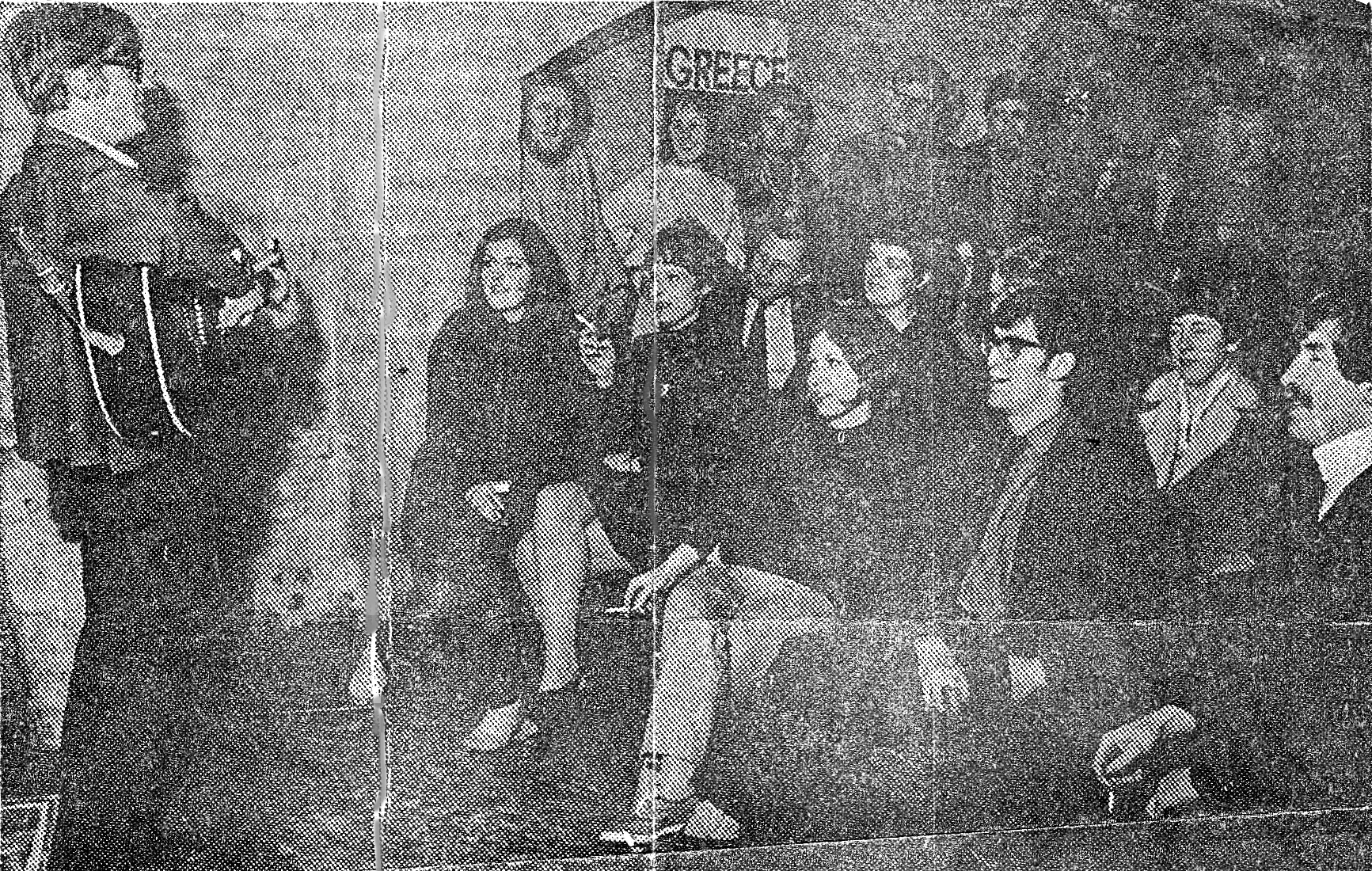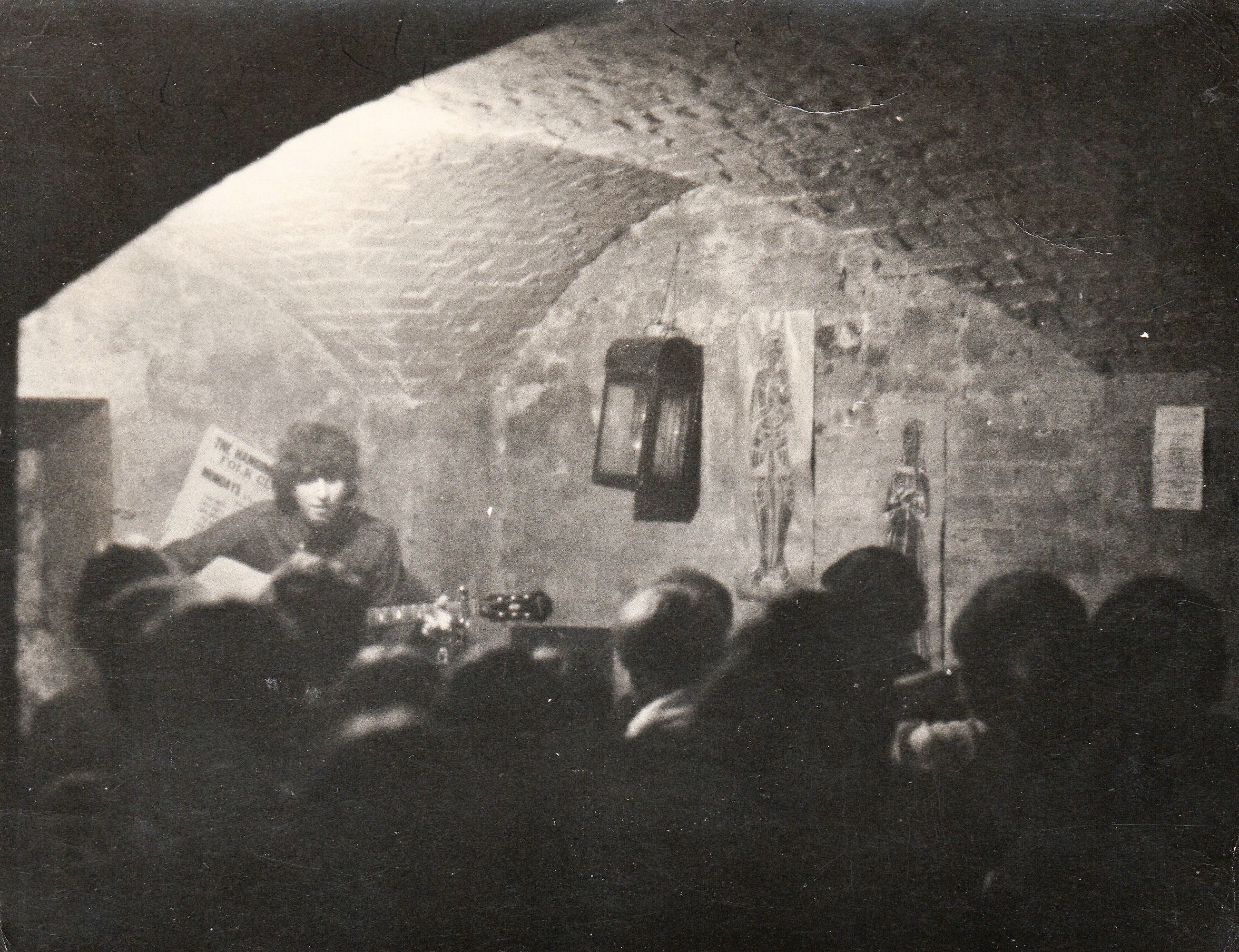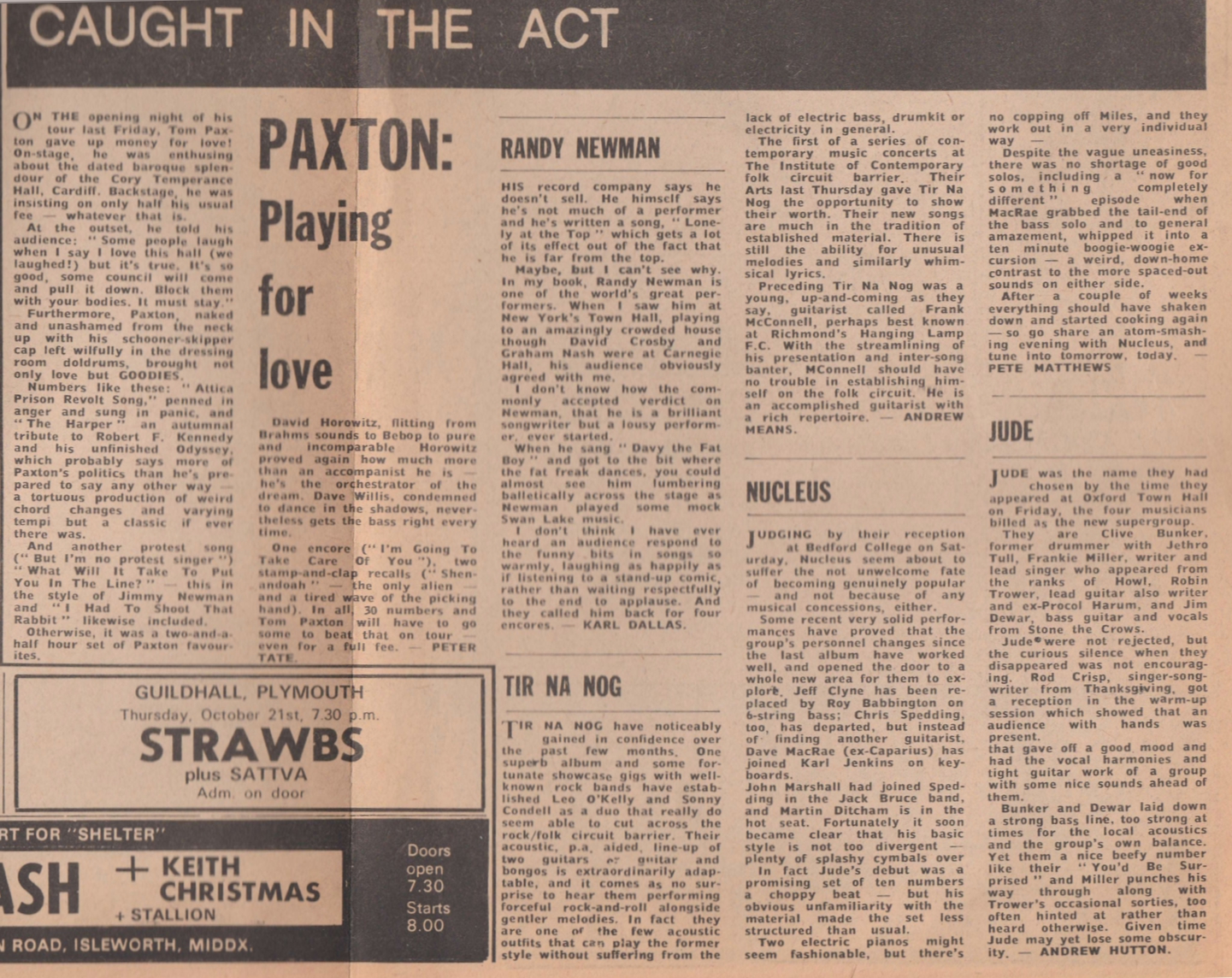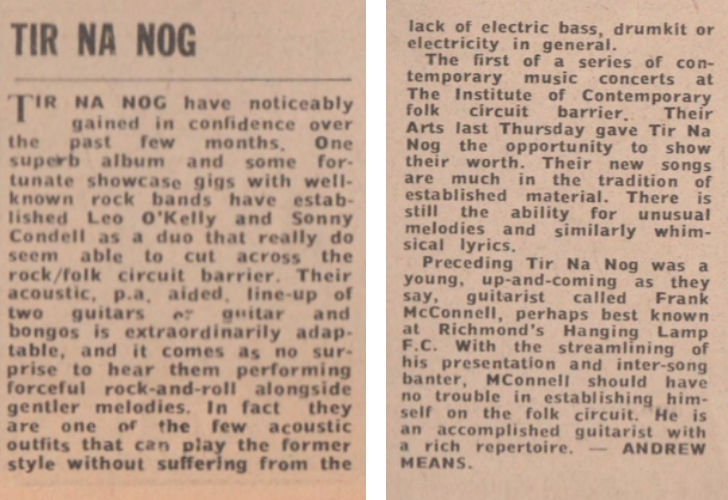1968 to 1972
Near the end of my College days, a fellow student, whom I didn’t know, came up to me in the bar. He was passing on a request from a young priest in East Sheen near Richmond in Surrey. Father Brian Maxwell wanted to open a folk club for the young people of his parish and needed someone who knew something about that kind of thing to help him. My fellow student could have asked any one of three or four of us. He happened to bump into me. Isn’t fortune brave? Fairly sceptical, I arranged to meet the priest.
Fr. Maxwell (thats what we called them in those days, Father, although he became Brian quite soon), took me to meet the parish priest of St Elizabeth’s in Richmond, Canon Davies I think, and he agreed to let us use the cellar of his church. He took us down there. It was filthy, with heaps of rubble and the dust and dirt of decades. Perfect! It had stone pillars and a vaulted ceiling which risked the bumps of anyone whose head was more than 5 feet off the floor. Although we didn’t know it at the time, it was like the Cavern in Liverpool, the famed base of the Beatles. The Hanging Lamp began and a Golden Age of Folk music in Richmond came into being.

I have put this photograph here because I find it very exciting. I am sorry I haven’t really had time, or maybe the software and the skills, to make it look wonderful but I was given this newspaper cutting by Karina Grabner just yesterday. I don’t think I have ever seen it before. It was very early in The Lamp’s existence. In the front row with the glasses is my good friend Tim Shepherd from Strawberry Hill and Clithero and peering round the arch at the top left of the Greece poster (heaven knows what that was doing there), is a very young and bearded Ian Shircore. Sadly, Karina is not in view and I apologise to all those people whose names have now long gone. I probably would have known them all. I will write more later!
Canon Davis couldn’t understand why on earth anyone would want to use his crypt! But we loved it. I was the resident at the Club throughout its time at first with Verity Stephens and later with Will Creavin. Ian had silky skills in persuading new and ‘getting established’ artistes to come and sing and play for us usually for pennies because that’s all we had!Within a few months, the Canon upstairs realised he had a gem downstairs and decided to close us down.
We were shocked and very disappointed but apparently he had seen the future and he had decided to renovate. He was going to close down our detritus and create something clean. The Canon couldn’t understand our dismay as he was going to create for us and for him, a formica renewal with green teacups. We tried hard to change his mind at least about the folk club room. We weren’t too bothered about our Green Room. The committee of ‘young people of the parish’ melted away all but Ian Shircore, me, and the necessary female support . We were determined to start up again. And we did.
Writer Ian Shircore and I meet occasionally, not least because of the current interest in the music scene in the Richmond area of that time. It feels a bit desperate that what was a big part of my early adult life is now being written up as history! But it’s not too surprising when the Lamp worked so well, Eel Pie Island was just up the road with its connections with the Rolling Stones and others, and just a bit further away, the Crawdaddy Club in Kingston was famous for its blues men! What an area, what a time, and did we know it? No not really! We just knew that the Hanging Lamp was the place to be.
Some big names rolled in… John Martyn, Al Stewart, Ralph McTell…. Some wonderful stories rolled out…
JOHN MARTYN
I wrote earlier about first meeting John Martyn when running the folk club at Strawberry Hill. That was the first meeting of many. John was a charming, friendly and chatty young man. I think he was 17 at that first meeting and I had the pleasure of working with him several times over the next few years. I met lots of whizz guitarists but most of them were well up themselves and John was not. More importantly, he was already producing the goods, had talent the size of a diamond mine with unexplored seams of treasure galore, and all the creative drive and ambition he needed to be a world force.
I say ambition but you know, I am not sure right now that that was what it was. Ambitious people are so often really pushy, John was not. He may have become that way later, I don’t know, but he certainly was not then. He just wanted to play and experiment and build and explore. He was walking off into space and from where the rest of us were, he had no support umbilical and yet he seemed so much in charge of what he was doing. I suppose I knew him best between about 1968 and 1972. Years later I saw a tv documentary about him in which he appeared throughout. He seemed like someone who had been bitten severely for some time.
One of the Hanging Lamp people rented a flat opposite the club in The Vineyard and we would all go over there after the club and the guitar playing would continue into the early hours. I learnt a lot jamming along with John. I could follow what he was playing melodically and harmonically but had no idea where his hands would be flying to next and even though the music was beautifully logical in its development, I couldn’t always work out how he was producing it. Sometimes his turns in the middle of a piece were unexpected and it would take to the end of the phrase to realise that you had continued straight down the road and he had turned left when you weren’t watching. He was using a lot of tunings of course and you needed to know what those particular combinations were before you could unlock the vault but even if I had known that particular tuning it would still have taken some time to know how to use it to produce these superb movements of melodic shifts, chordal patterns and decorative riffs.
Whilst I watched him, we all did, he was watching us.
‘Have you had lessons, Frank?’
‘No’. I was and am self-taught (like most of us at that time). ‘Why?’
He commented on my technique. I had not noticed, even if John did, that my hands stayed low! I’ve kept them that way. He saw that kind of thing. I’m not sure that I did.
‘You mostly stick with normal tuning?’
‘A bit of dropped D but not much else’. I was trying to play in straight tunings. I wanted to play anything and everything that way.’ I’m still doing that! John experimented all the time. He would settle on a tuning for a while then adjust it because of something he wanted to do. He was always pushing the edges and would work for weeks in one direction before running off to a different angle altogether.
We jammed a lot although in truth, it was hard to jam along with someone like John, by the time you had worked out the harmonic structure of what he was doing, the song was usually finished.
Ian Shircore began to see the possibilities in putting on concerts and he directed a season at the Institute of Contemporary Arts (The ICA) in The Mall in London – the first place I knew that sold seaweed as food! (I hadn’t met laverbread yet), in York University, and in Richmond, Surrey and several times I was first half warm up for the holy triumvirate of John, Al, and Ralph. I was honoured. I was nothing like as well known as Ralph or John who also had top song writing skills. We were all about the same age but somehow they had packed loads more understanding into their lives than me.
One of the concerts featured Tir na Nog. The Melody Maker had a weekly feature called Caught in the Act and I featured somewhere in that every now and then. Andrew Means was one of the folk reporters and I met him several times. Karl Dallas was another but our paths never crossed which was a shame. Dallas had been an entertainer, writer. political activist and you name it for some years. I shall quote Dallas elsewhere with some amusement. Andrew Means never quite understood what I was trying to do as shown by the closing paragraph from the close up of the above Tir na Nog review.
Nice to see the ad for The Strawbs at Guildford on the same page as the Caught in the Act from the October 16th 1971 edition of the paper.
SANDY DENNY, JO LUSTIG
At one of the concerts in Richmond, Jo Lustig, the Folk Impresario, turned up. I didn’t know who he was until later and he gave me the ‘Come up and see me sometime’ line. Sandy Denny was with him and we three had the kind of chat that I was good at at that time. I can’t really say that I had no confidence in myself at that time. I think I at least looked confident and I had no problem being in front of people on stage but I had no idea of where I was in the hierarchy of guitarists of the time. I had not been brought up to rate myself in any way, to think of myself as being Mr High and Mighty and indeed if anyone in my part of the world did anything to suggest that they thought themselves to be ‘a bit good’, they would be smacked down in no time at all. Many many years later, I came across the Law of Jante, go on, look it up, and I recognised 50s and 60s Tyneside as being part of that culture. In general, that’s a great shame because whilst it’s meant to manage ‘the sin of pride’, it stultifies and stands on creativity.
Sandy was a pleasant young lady, easy to talk with and about the same age as me. Jo was a charming man with, as I later found out, a stunning track record in the music world. I didn’t ‘come up and see him sometime’ but I should have. But then, I wouldn’t have had the life I’ve had!
SPIKE MILLIGAN, MARIANNE FAITHFUL
Ian Shircore had made a contact with the ICA, the Institute of Contemporary Arts in The Mall in London and organised a season of concerts there. She was a very pleasant contact, ‘Call me Lindy…’ so I did. She turned out to be Linda Dufferin, Lady Linda Dufferin, a member of the Guinness family.
The concerts followed a familiar Shircore pattern with me playing the first half and Al Stewart or John Martyn or Ralph McTell headlining.
One spin off from these was that I was asked to play at a charity bash, I can’t remember what for and readily agreed when told that Spike Milligan was on the bill. Sadly Spike didn’t turn up but backstage I was hustled out of the way by Marian Faithful who was rushing round the back of a set to get into position for her next scene. She didn’t look her best but I am hoping that that was because she was in character. Her character was not the one that had glued many a male eye to the screens when watching Girl on a Motorcycle.
That reminds me. Some time later, around 1974, a friend in Richmond called Richard Newman had arranged a couple of dates for Thames TV. In those days, television ended with an epilogue followed by a bright white dot on switch off. The epilogue had been a religious content 3 minutes but by now had gone through something vaguely spiritual towards something suggesting ‘a thought’. The week’s thought was Songs of the City and was to be broadcast over the London and south east area. I got the Friday and Saturday nights. I think Digance had the Thursday. That must have ben annoying. I was told after that I had had the biggest audience for an epilogue that Thames had ever had. I suspect this was because the film preceding it was Girl on a Motorcycle and the men at least were waiting to see if she would come back on.
They repeated the series about a year later and that blew my cover as by then I was a Deputy Headteacher in a Primary School in Kent.
AL STEWART PART 1

Al Stewart was the bane of my life. He would turn up at the club out of the blue every now and then. He always seemed to have a new pretty girl on his arm but he never seemed to have a guitar in his hand. He would borrow my Epiphone Cortez (as he had in the photograph above). He liked the Cortez, he had one too, but would then proceed to complain about it. I couldn’t afford to put new strings on it every five minutes and he was not happy with that. He never seemed to turn up when I had put new strings on though.
AND OTHERS TOO
There were others whom I enjoyed very much like Marion Segal (www.mariannesegal-jade.com and Noel Murphy, the big Irish entertainer who really was so much fun. The Irish duo Tir Na Nog always went well. Sonny and Leo played lovely tunes which allied to warm personalities pretty well guaranteed a good night. I think it was Leo who played an excellent Jimi Hendrix back in the Vineyard flat. Ray and Philomena Durham played the club a few times and we had great nights ‘Driving Across Mythical America’ with Pete Atkin. Ian Shircore, in his book ‘Loose Canon – The Extraordinary Songs of Clive James and Pete Atkin, tells a splendid story of Pete coming to the Hanging Lamp out of the blue with an Australian minder who seemed quite a presence at the time. He turned out to be Clive James.
Next… still in production!


